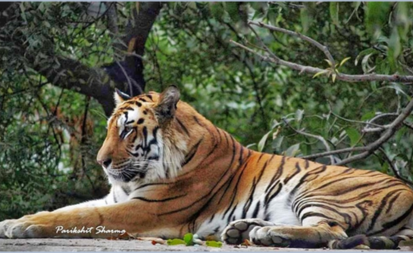The Tiger Reserve Hexagon Madhya Pradesh
-Article contributed by Prof. A. K. Singh, Head, Jagran School of Hotel Management & Tourism, Jagran Lakecity University, Bhopal MP Dr. Parikshit Sharma, Associate Professor, Jagran School of Hotel Management & Tourism Jagran Lakecity University, Bhopal MP Isha

-Article contributed by
Prof. A. K. Singh, Head, Jagran School of Hotel Management & Tourism, Jagran Lakecity University, Bhopal MP
Dr. Parikshit Sharma, Associate Professor, Jagran School of Hotel Management & Tourism Jagran Lakecity University, Bhopal MP
Isha Pabia, Research Scholar, Jagran Lakecity University, Bhopal MP
Priya Sharma, Head of Department, Institute of Hotel Management Raipur CG
The serene sound of river Ken, and the rustling leaves of Teek trees shading with mild sunshine all over the place, were making us mesmerized when the roar of a tiger piercing through dense forest reached our ears, and this roar was the strongest I’d heard till now, a primal sound that sent shivers down the spines. No, this isn’t a scene from a movie but this heart-fluttering reality was my adventure through ‘The Tiger Reserve Hexagon of Madhya Pradesh’.

Source: (Visiting National Parks / Sanctuaries, 2024) and Authors
There are 55 Tiger Reserves in India out of which 06 are situated at Madhya Pradesh (EIACP Programme Centre “Wildlife & Protected Areas Management”, 2024). Due to my interest in wildlife and nature and also to have some quality time with my family I booked the thrilling experience preserved at the “Heart of India”. The best time to embark on this adventure is the Winter season. Fortunately, I managed to book my trip in November which happens to be the
best time of the whole season. The Tiger Reserve Hexagon encompasses six Tiger Reserves. This mosaic of six protected areas consists of Satpura Tiger Reserve, Pench Tiger Reserve, Kanha Tiger Reserve, Bandhavgarh Tiger Reserve, Sanjay Tiger Reserve, and Panna Tiger Reserve.

Source: Authors (2024)
This journey began in Bhopal (Madhya Pradesh). After traveling 110 km and a roughly two-hour drive, we reached Satpura Tiger Reserve, a gem hiding in Satpura (a Sanskrit word meaning Sat – seven and Pura – mountain) Mountain Range which was first explored by Captain James Forsyth of Bengal Lancers in 1862 while searching for the Indian Freedom Fighter Tantya Tope (History of Satpura National Park, Satpura Forest History, Satpura History, Satpuda History”. , 2024). It includes the three highest peaks of Central India i.e. Dhoopgarh (1352 m), Mahadeo (1330 m), and Chauragarh (1308 m). Lush forests, cascading waterfalls, and sprawling meadows were painting a breathtaking experience when a flying squirrel just swirled in front of us at some distance. Recommended stay is at the forest rest houses in Madhai or Churna which will engross you with their breathtaking views and wild calls at night.
Next, I ventured to Pench Tiger Reserve (130 kms, a 3-hour drive from Satpura TR), where specifically at Turia zone, we spotted a magnificent tigress with her cubs, their stripes blended seamlessly with the sunlight covering the forest beds. Gosh! it was an experience worth remembering. During our stay here, we got the opportunity to know the culture from near; as many folk dances and cultural activities are arranged for the tourists by the local community members, covering all the pillars of ecotourism. The forest rest house at Seoni or MP Tourism hotel at Turia gate is recommended to stay while having local food and stories of wild hunt from the hotel staff.
You may have read Rudyard Kipling’s “The Jungle Book”, where, he mentioned “Mowgli” and there is a debate about whether he belonged to the forests of Pench or Kanha. The officials told us many stories about his presence at Forest of Pench when we were on the Jungle Safari. So, with a curious mind of Indiana Jones, we moved forward to Kanha Tiger Reserve to know their side as well. Kanha Tiger Reserve, which has the highest number of tigers out of all six tiger
reserves of this hexagon, has beautiful sights to cherish too (220 kms, and a 4 ½ hour drive from Pench). Out of which at Bammi Dadar we witnessed one of the most beautiful sunsets with a cup of tea. We also managed to see “Neelam (Tigress T-65)” who is also considered the Queen of Kanha Zone.

Neelam (Tigress T-65)
Source: (Kanha National Park, 2024)
The next stop was among the Indo-Malayan Realm, Bandhavgarh Tiger Reserve. A settlement that dates back to pre-Christ times, if not the pre-historic era. On the way to our jungle safari, we got to see the man-made ancient caves with inscriptions and paintings. Moving further, we encountered a majestic tiger resting on a rock. The ancient fort of Bandhavgarh also tells a story, signifying, it was given to Brother Lakshman by Lord Ram, to keep watch on Lanka, and hence the fort acquired the name “Bandhavgarh” (Bandhav – brother, Garh – fort). Situated in the Umari district; it is 220 kms, a 4 ½ hours drive from Kanha.
Now is the time to cherish another tiger legacy “Mohan” at Sanjay-Dubri Tiger Reserve (roughly 190kms and 4-hours journey to the two states sharing it across the borders for districts – Singrauli (MP) and Manendragarh-Chirmiri-Bharatpur (CG). “Mohan” was the white tiger rescued by the Maharaja of Rewa during his hunting in 1951. Later he was bred to “Radha” and the white tigers we see in zoo across the world today are considered their progeny only (MP Online (Forest), 2024). There is a green wildlife corridor covered with tall Sal trees which connects Bandhavgarh and Palamau Tiger Reserve and is often used by elephants as their shelter. Our journey concluded at Panna Tiger Reserve, a prime land of tigers in Vindhya Hills (310 kms and 6 ½ hrs drive), where river Ken flows and where we heard the roar, I mentioned in the starting. The national park was created in 1981 and later declared as Project Tiger Reserve in 1994. It is also a home to the gharials and magars of the Ken River. Interesting to note is the Pardhi forest communities, once the hunters assisting the British during their trophy hunting; they are now trained to become naturalists, protectors of the forest, artisans and employees of the tourism and hotel boards with the interventions of the Last Wilderness Foundation, forest, and tourism departments and the Taj hotels.
If you are someone looking for serenity and adventure simultaneously and would like to go with your family or friends, Tiger Reserve Hexagon of Madhya Pradesh has the potential to fulfill all your needs. The experience here is not limited to nature and wildlife but one gets to interact with local communities, have meals prepared by them, and feel their culture by being a part of various cultural programs arranged at these tiger reserves, which is the essence of Responsible and Ecotourism initiatives. Always remember to follow the guidelines of the tiger reserves and adopt sustainable practices to preserve and protect the flora and fauna living there.
The Tiger Reserve Hexagon is a concept note created by the authors for promotion of tiger reserves of Madhya Pradesh.
References
(2024). Retrieved from MP Online (Forest): https://forest.mponline.gov.in/eBrochure/eBrochureDetails.aspx?parkid=STR#:~:text=The%20world%20famous%20white%20tigers,and%20bred%20to%20tigress%20Radha.
EIACP Programme Centre “Wildlife & Protected Areas Management”. (2024). Retrieved from Wildlife Institute of India, Dehradun: https://wiienvis.nic.in/database/trd_8222.aspx
History of Satpura National Park, Satpura Forest History, Satpura History, Satpuda History”. . (2024). Retrieved from satpura-national-park.com
Kanha National Park. (2024). Retrieved from Neelam, the Tigress: https://www.kanha-national-park.com/blog/tigress-neelam-t-65/
Visiting National Parks / Sanctuaries. (2024). Retrieved from Forest Department, Govt. of MP (2024) : https://mpforest.gov.in/HO_Outer/FOREST_Visit_NationalPark.aspx
—–
 English
English French
French German
German Italian
Italian



